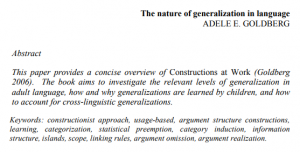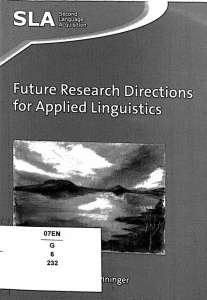PDF #96 – Adele E Goldberg – The nature of generalization in language

This paper provides a concise overview of Constructions at Work (Goldberg 2006). The book aims to investigate the relevant levels of generalization in adult language, how and why generalizations are learned by children, and how to account for cross-linguistic generalizations.
How do learners acquire generalizations such that they can produce an open-ended number of novel utterances based on a finite amount of input? Why are languages the way they are? In order to address these long-standing questions, many linguists with varying backgrounds have converged on several key insights that have given rise to a family of constructionist approaches. These approaches emphasize that speakers’ knowledge of language consists of systematic collections of form-function pairings that are learned on the basis of the language they hear around them. This simple idea is, to my mind, what sets constructionist approaches apart from traditional generative grammar. The learning of language is constrained by attentional biases, principles of cooperative communication, general processing demands, and processes of categorization.
The term constructionist is intended to evoke both the notion of “construction” and the notion that our knowledge of language is “constructed”
on the basis of the input together with general cognitive, pragmatic and processing constraints. It is intended to be a more inclusive term than Construction Grammar, as the latter is a particular instance of a constructionist approach.
After reading “The nature of generalization in language” you can check important issues for ESL teachers on the section PDFs and visit my channel by YouTube.

